Texas is a vast state with a wide range of landscapes and climates. It is home to an astounding variety of mushrooms, from the iconic, edible morel to the inedible death cap mushroom.
Other common mushrooms in Texas include chanterelles, wood blewits, boletes, and shelf mushrooms.
This article will explore the various types of fungi that can be found in Texas and discuss ways to identify edible varieties. Through this, you will gain insight into the unique biodiversity of this great state.
List of Edible Mushrooms in Texas
1. Chanterelles
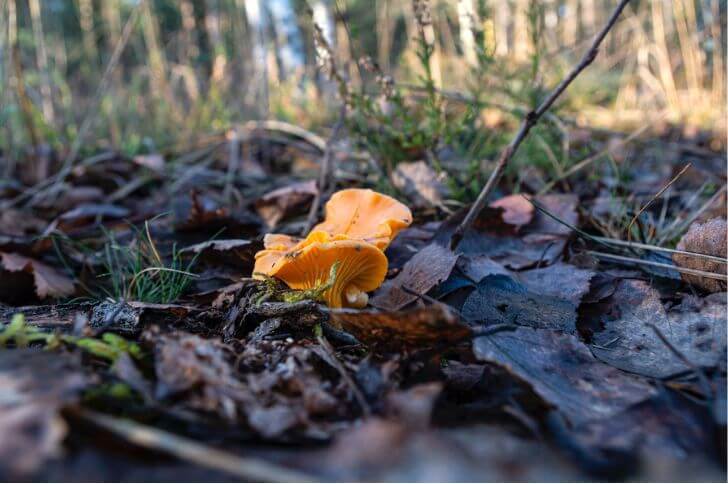
Common chanterelles in Texas include:
Cantharellus septentrionalis: These yellow mushrooms in Texas are a member of the golden chanterelle family. One way to identify this chanterelle is by examining its physical characteristics.
The cap of the mushroom is generally funnel-shaped with ridges or folds on the underside. The stem is usually thick and sturdy, with a yellowish coloration that fades towards the base. The flesh of the mushroom is firm and dense.
Another key feature of this chanterelle is its habitat preference. This species typically grows in coniferous forests, often near pine or oak trees.
Cantharellus tabernensis: Common in the Southern United States, this chanterelle has a distinct yellow-brown coloration. The cap of this mushroom is funnel-shaped and can grow up to three inches in diameter. Additionally, the stipe or stem of the mushroom is thin and long compared to the other chanterelle above.
Craterellus odoratus: This yellow fungus is common in Ohio, Florida as well as Texas. One of the most distinct features of C. odoratus is its funnel-shaped cap that stretches downwards into a long stem. The cap is usually bright yellow in color and has deep ridges running down its length. The underside of the cap has gill-like folds that are lighter in color than the rest of the mushroom.
Cantharellus texensis: Unique to TX, the Texas chanterelle, is a highly prized edible mushroom that grows in the southern United States.
One of the key features of Cantharellus texensis is its bright yellow-orange coloration. The cap is often wavy or funnel-shaped and has a soft texture. Underneath the cap are gill-like ridges that run down the stem. These ridges are forked and vary in length, giving them a distinctive appearance.
2. Morel Mushrooms in Texas
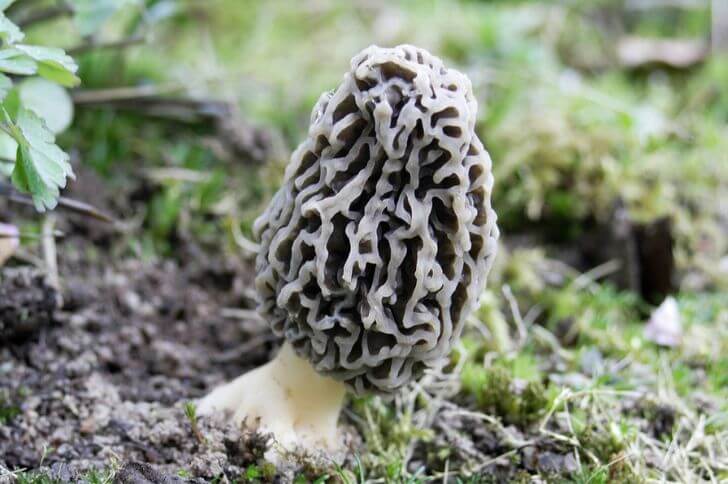
Yellow Morels
One key characteristic of yellow morels is their cap shape. The cone-shaped cap has deep ridges that run down its length, creating a honeycomb-like appearance.
Another identifying feature is the color – true to their name, yellow morels have a bright yellow hue that can range from pale lemon to deep gold. Finally, the stem of these mushrooms is typically white or light-colored and hollow on the inside.
When it comes to cooking, these Texas morels are often used in soups and stews or sautéed and served with pasta or rice dishes.
Black Morels
The first thing to look for when trying to identify Black Morels is their distinctive shape. They have a cone-shaped cap that is deeply pitted and ridged. The cap is attached to a hollow stem that is often lighter in color than the cap itself. Black Morels can vary in size from just a few inches tall to over 6 inches.
Another important factor to consider when identifying these morels in Texas is their habitat. These mushrooms grow best in environments with well-drained soil and plenty of moisture, such as forests or grasslands.
3. Ganoderma Sessile
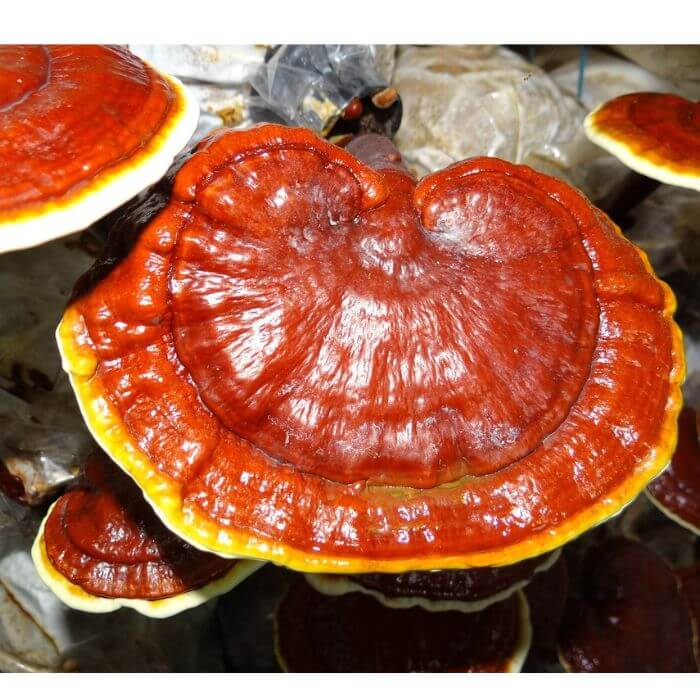
Ganoderma sessile is not edible. However, it can be used in making teas. It is a type of polypore fungus that typically grows on dying trees of hardwood forests.
The shelf-like fruiting body is usually large and can measure up to 7.8 inches in diameter. Its color ranges from reddish-brown to dark brown with a shiny surface. On its underside, this shelf fungus has tiny pores.
The stem of the mushroom is short and stubby, sometimes absent, often attached off-center to the cap.
4. Snow Fungus (Tremella fuciformis)
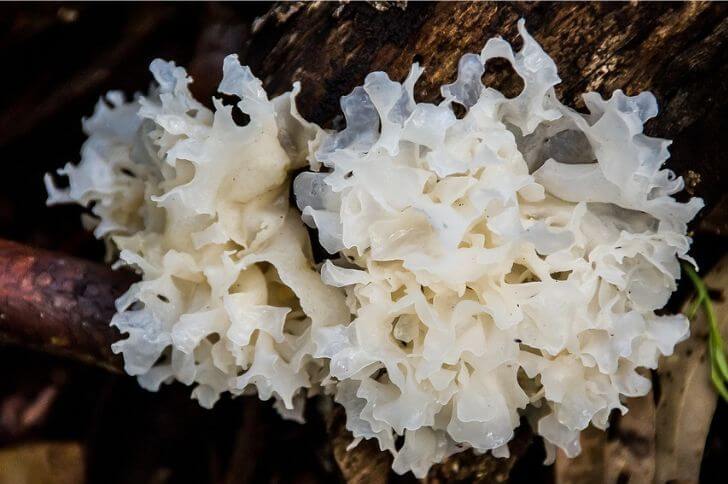
The snow fungus or white jelly mushroom is edible. However, its not loved for its taste but its gelatinous texture that makes soups thicker.
Scientifically called Tremella fuciformis, this white Texas mushroom is a popular ingredient in traditional Asian cuisine.
One way to identify it is by its unique appearance. It has a wavy, lobed shape that looks like an ear or brain with a translucent white color that turns yellowish when dried. Its texture is gelatinous and rubbery when fresh but becomes brittle when dry. Additionally, it grows on dead hardwood trees all year round.
These white mushrooms in Texas have a small fruiting body, growing to about 2.7 inches across.
Related Read: Check Kansas Mushrooms
5. Puffballs
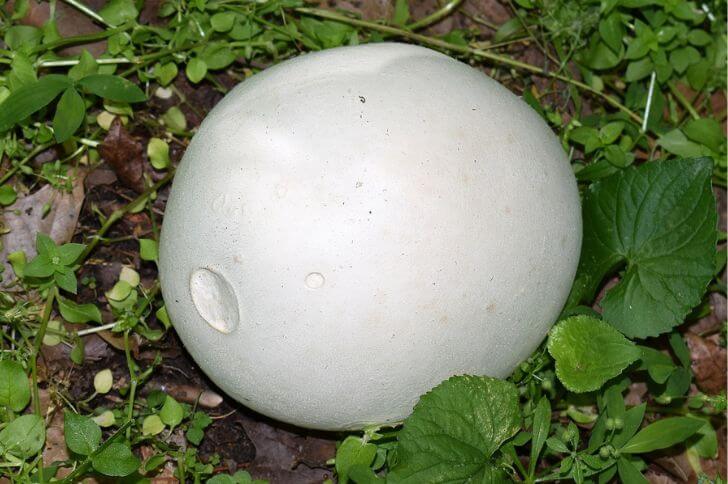
Here are varieties of puffball mushrooms in Texas.
Calvatia bovista: This Texas puffball is characterized by its round top and a wide base. The outer layer of the mushroom is white or light brown with small bumps, while the interior is filled with spores. It grows to about 9.8 inches.
Calvatia cyathiformis: One of the most notable purple mushrooms of Texas are the purple-spored puffballs.This fascinating mushroom can grow up to 7.8 inches in diameter and has a round shape. Its outer surface is covered in small scales or warts that can range from light gray to dark brown, while its interior is composed of white flesh that turns yellowish-purple as it matures.
Calvatia rubroflava:The Orange-staining Puffball, scientific name calvatia rubroflava, is named for its bright orange color and the way it stains when touched or cut. The orange-staining puffball belongs to the family Agaricaceae and is closely related to other puffballs.
The fruiting body of this mushroom can range from light yellow-orange to dark reddish-brown, with a smooth surface that becomes wrinkled with age. When it is handled or damaged, however, the flesh turns an intense shade of orange-red. This makes it easy to identify in the wild even when it has not yet matured fully.
Calvatia gigantea: Giant puffballs are common white mushrooms in Texas. This fungus is famous for its enormous size, which can grow up to 25 inches in diameter and weigh over 44 lbs. Because of its impressive appearance, this white mushroom is relatively easy to identify due to.
One way to recognize it is by examining its outer surface. The mushroom has a smooth and white exterior that may develop brown spots as it matures.
Its shape can vary from spherical to irregularly shaped with a flattened base where it attaches to the ground. Another way to identify this mushroom is by cutting it open. The flesh inside should be pure white with no gills or pores visible.
Lycoperdon pyriforme: Commonly called the stump puffball, this is another type of white mushroom of Texas. Its fruiting body consists of a small stem that connects to a round or pear-shaped cap. The cap is white when young but turns brownish-yellow as it matures.
The surface of the cap is covered with tiny spiny projections that eventually fall off and leave behind a smooth surface. When ripe, the puffball splits open at the top releasing clouds of brownish-black spores which are dispersed by wind.
6. Chicken of the Woods
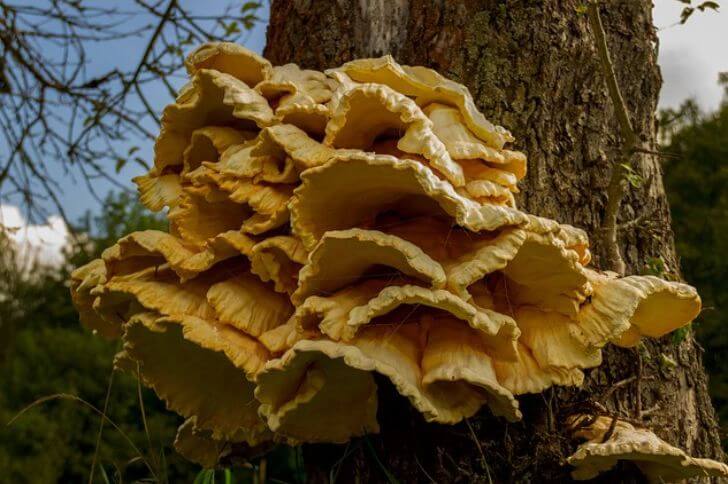
Chicken of the woods is a popular wild edible mushroom in Texas that has been used in various culinary dishes for centuries. If you are a novice forager, there are several key characteristics to look out for when trying to identify chicken of the woods.
Firstly, the fruit body of this fungus is generally large and fan-shaped, with overlapping shelves that grow horizontally from trees or logs. The color varies between bright yellow to orange-yellow with a velvety surface on top and pores underneath.
Secondly, it has no stem or cap like most mushrooms; instead, it grows directly from wood. Thirdly, it has a soft and spongy texture with a mild flavor that tastes similar to chicken meat when cooked correctly.
7. Amanita Jacksonii
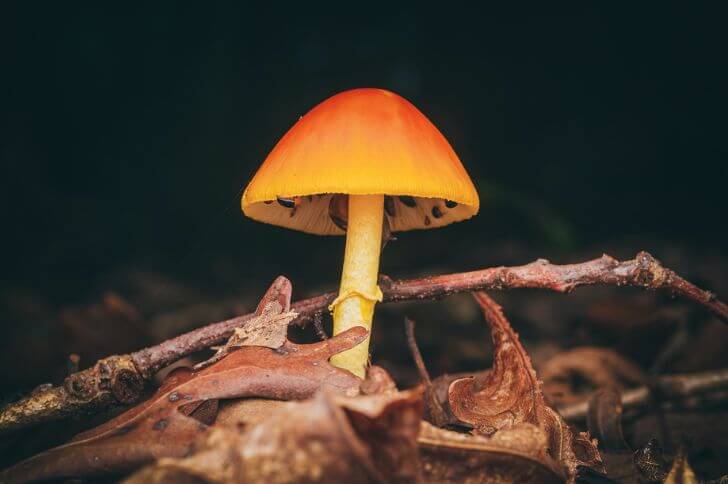
Eastern Caesar’s Amanita or Amanita jacksonii is a beautiful red mushroom in Texas. Young specimens are enclosed in white volvas, they look like scattered eggs.
Within a few days, they emerge from the sack-like structure, revealing red-orange mushrooms with yellowish margins. Stems are yellowish-orange with red fibers and grow to about 6 inches tall. Note, the caps become flatter as they mature.
Though listed as edible, we recommend you avoid it because it can be confused with other inedible species.
8. Black Trumpets (Craterellus fallax)
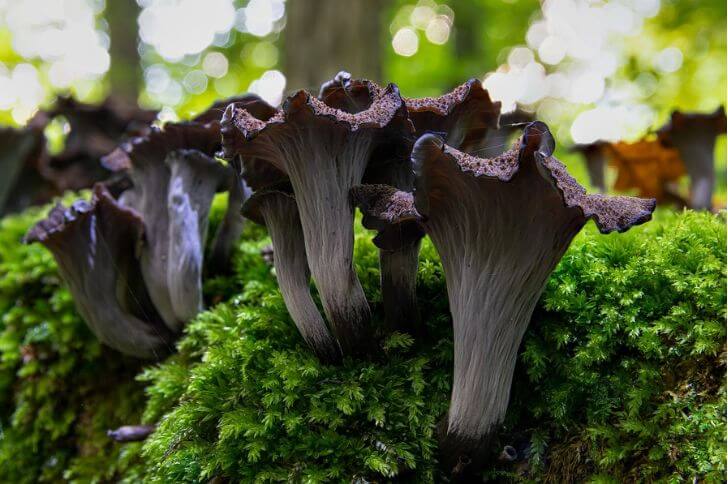
Craterellus fallax or the black trumpet mushrooms is an enigma; this Texas fungus is common but hard to find due to its unique features.
One of the key features is its funnel-shaped cap that is black or dark brown in color. The caps are usually 1 to 4 inches wide and have a wavy edge that creates an irregular shape. Underneath the cap are thin ridges instead of gills, which run down onto the stalk to form wrinkles or folds. The stalks are usually short and thin compared to the size of the cap.
Because of its brown/black color and shape, this black fungus is able to blend into the background making it difficult to discover. So, when foraging for mushrooms, we recommend you carefully check in mossy areas from spring through fall.
9. Sordid Blewit (Lepista sordida)
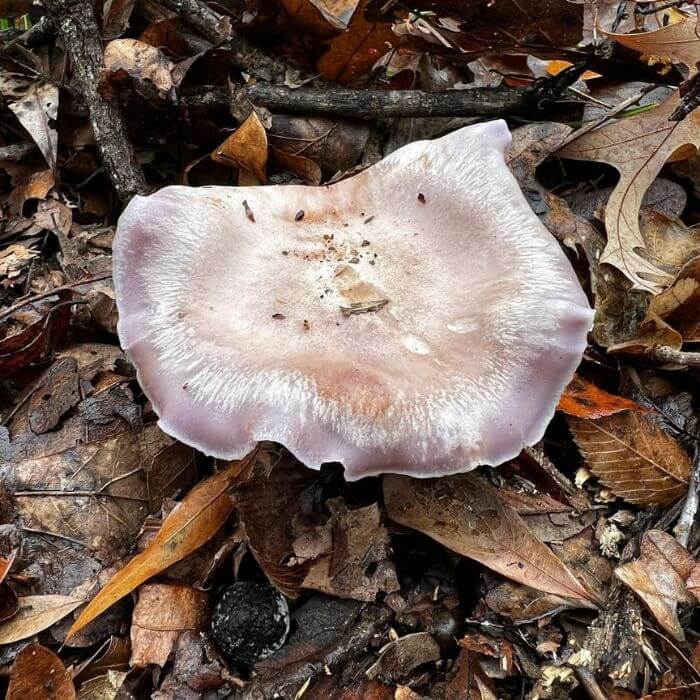
source:thebotanicalnomad
Related to wood blewits, sordid blewits are a species of mushroom that belongs to the Tricholomataceae family.
It has a distinctive violet cap with a smooth surface that can reach up to 3.1 inches in diameter when fully grown. Also in maturity, the cap curves upwards. The stem is cylindrical and usually measures around 2.3 inches in length.
On the underside, this blewit has lilac gills that turn buff in maturity. Like wood blewits, sordid blewits are edible. However, they don’t have a distinctive taste but that has not stopped me from adding them to my omelets and pasta dishes.
10. Ringless Honey Fungus (Desarmillaria caespitosa )
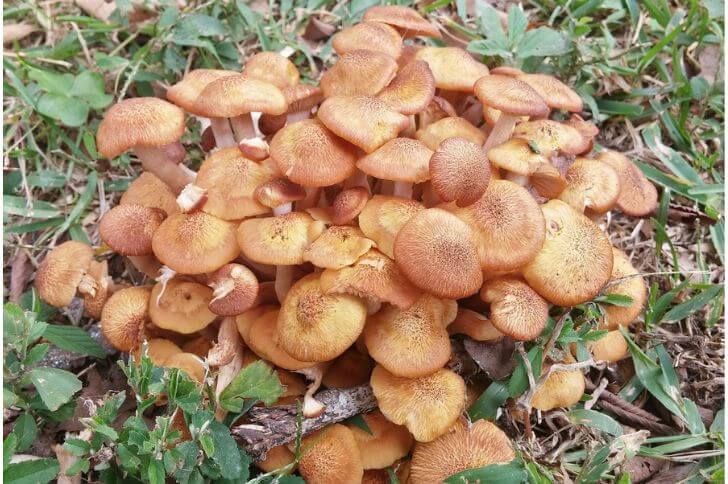
Desarmillaria caespitosa, commonly called the ringless honey mushroom, is a brown species of fungus that favors parts of TX.
While this mushroom is known for its edible properties and pleasant taste, it’s important to be able to identify it correctly before consuming it. Here are some key features to look out for when identifying desarmillaria caespitosa .
Firstly, its cap ranges from 1-4 inches in diameter and dark scales. The gills on this mushroom are pale, turning pink-brown in maturity. The stem itself is usually between 1-4 inches long.
Where can you find honey mushrooms in Texas? They grow in clusters at the base of stumps or trees. When harvesting, check for groups with young specimens. Ensure to cook the caps thoroughly and only consume a small amount.
11. Scalycap Mushrooms (Pholiota adiposa)
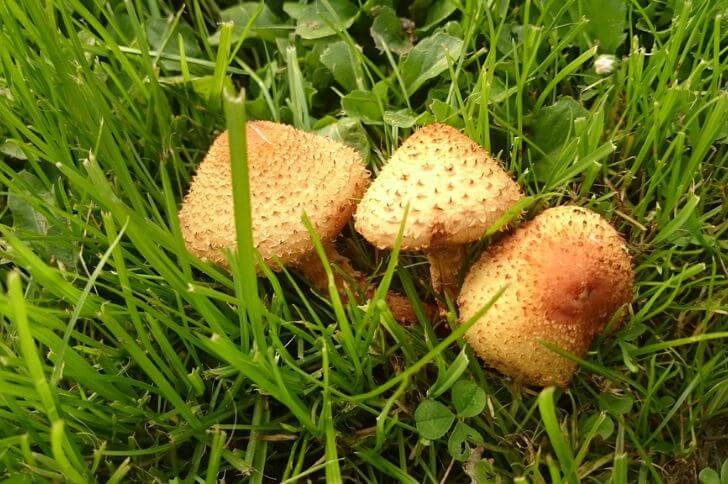
This scalycap mushroom does stand out. With its beautiful fruiting body, it’s hard to miss this mushroom when foraging. It’s common in Texas between August and November, growing on beech and willow trees.
The fruiting bodies of the mushroom are typically small and have a cap that ranges from 1.9-3.9 inches in diameter.
The color of the cap varies depending on its age; young caps tend to be brownish-yellow while older ones turn darker brown. The surface of the cap is covered with fine scales or hairs that may become sticky when wet. Gills underneath are initially yellow but darken with age to become brown.
Though listed edible, like other pholiotas we recommend you avoid them and opt for taster mushrooms like the oysters below.
12. Oyster mushrooms
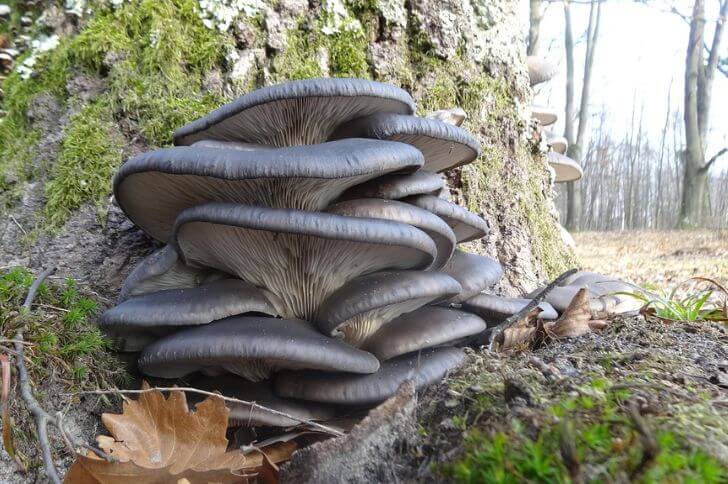
Do oyster mushrooms grow in Texas? Yes, particularly pearl oyster mushrooms grow in the wild in Texas. Other varieties like pink oysters and blue oysters can be grown at home with the right kit.
These mushrooms have a distinctive shape and texture, making them easy to identify if you know what to look for.
Oyster mushrooms typically grow on dead or dying trees, logs, or stumps. They have broad caps with a distinct fan shape and can range in color from grayish-white to brownish-gray.
The caps also often have a slightly wavy edge and may be smooth or slightly velvety to the touch. In addition to their unique appearance, oyster mushrooms also have a pleasant earthy scent which can help with identification.
13. Clustered Coral (Ramaria botrytis)
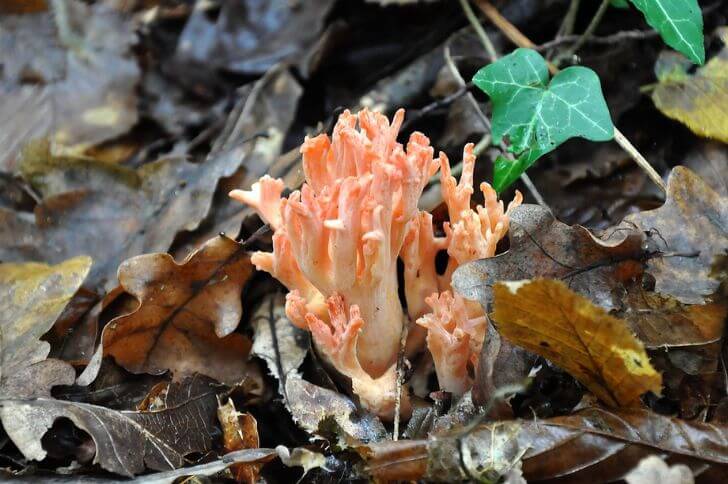
Are there coral mushrooms in Texas? Yes, there are various species of coral fungi in TX. A common fungus is the clustered coral or ramaria botrytis.
It is easily identifiable by its clumpy, finger-like branches that grow together in compact clusters. The fruiting body can range from 2.5-11.8 inches in width and is typically yellowish with pink-red tips.
Are these corals edible? Yes, but they are very rare so it’ll be hard to find enough for a meal.
Inedible Texas Mushrooms
14. Trametes Lactinea
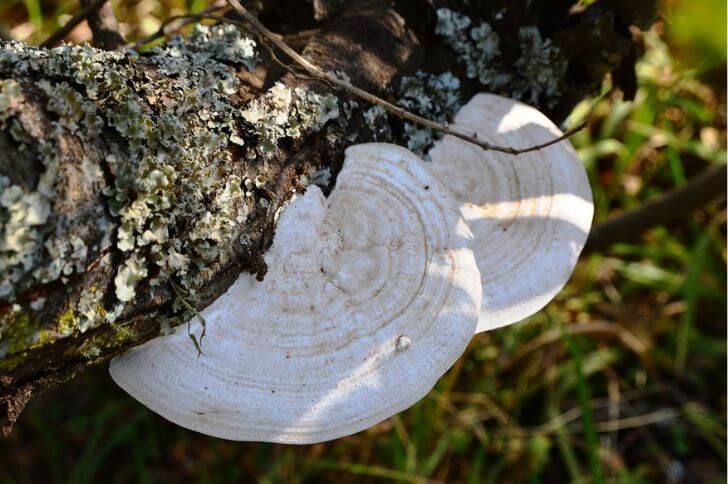
Trametes lactinea is another type of shelf fungus that grows in Texas. It has a white or cream-colored cap. Its surface can be smooth or warty depending on the age. Fruiting body can grow up to 7.5 inches wide.
15. Reddish Brown Bitter Bolete (Tylopilus rubrobrunneus)
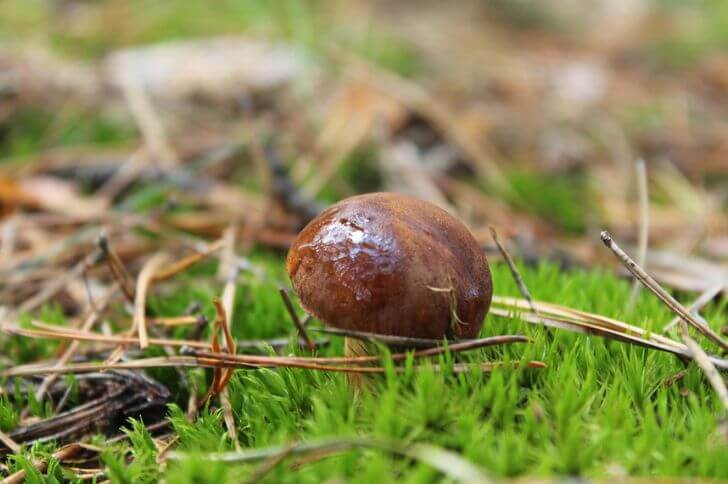
Tylopilus rubrobrunneus is a species of mushroom that belongs to the genus Tylopilus, which is found in North America. It is commonly known as the red-brown bitter bolete due to its reddish-brown cap and bitter taste.
The cap of this red mushroom in Texas typically measures between 1.9-5.9 inches in diameter and has a convex shape. The surface of the cap appears dry and leathery. Underneath, like other boletes, they have pores
This bolete has a long stem that grows to 6 inches. It is thicker towards the base. When sliced, this bitter bolete has white flesh that doesn’t change color. Unlike most boletes, the reddish brown bitter boletes are inedible due to the very bitter taste.
16. Common Stinkhorn (Phallus impudicus)
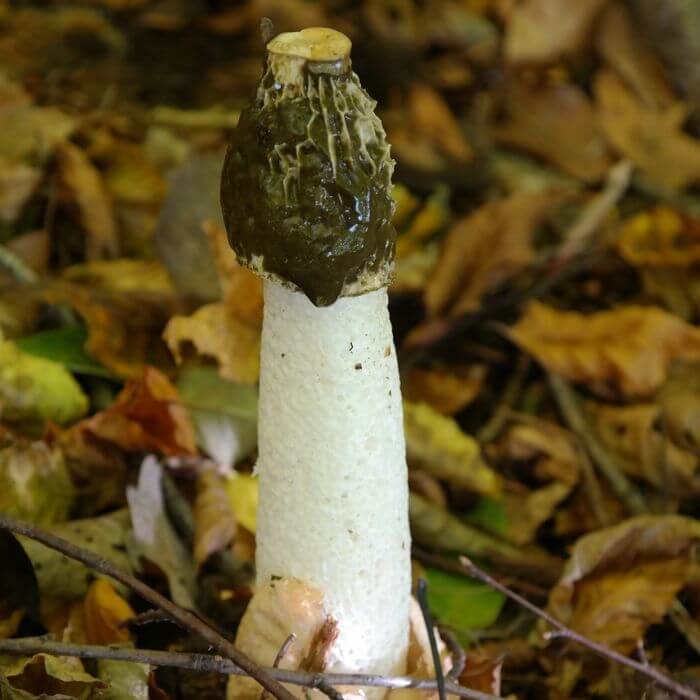
Common stinkhorn mushrooms are one of the most common inedible mushrooms of Central and East Texas. Scientifically referred to as phallus impudicus, you can identify it by its bell-shaped cap that can range in color from pale cream to olive-green. Cap has pits and ridges, similar to morels.
The next key feature to observe when identifying is its stem. The stem of this mushroom is long and slender.
At the base of the stem, there is often a bulbous structure called a volva. This volva may be hidden underground, so searching carefully around the base of the stem can be helpful.
Also, ‘their rotting flesh’ smell will help you identify them from far. Common stinkhorns are inedible.
17. False Turkey Tail mushrooms
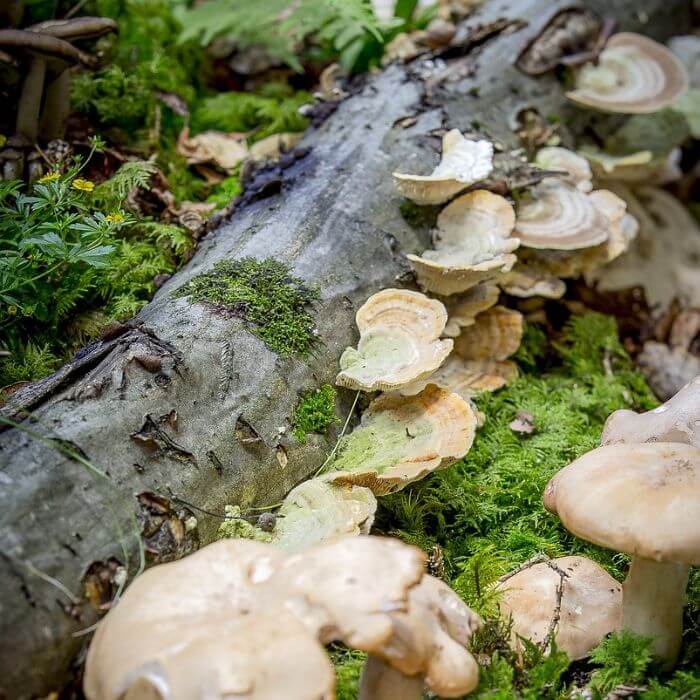
False Turkey Tail mushrooms are often mistaken for the true turkey tail mushrooms. How can you tell these shelf mushrooms apart?
The cap of a false turkey-tail is usually more reddish with fewer pores than that of the real thing. Note, if algae grows on its surface, it appears more greenish.
Another key difference is that this shelf fungus has larger kidney-shaped fruiting bodies, and grows to 2.76 inches wide.
FAQs
Where to go mushroom hunting in Texas?
One great place for mushroom hunting in Texas is the Piney Woods region. Covered with towering pine trees and dense undergrowth, this area is home to various species of edible mushrooms such as oyster, chicken-of-the-woods, and shiitake.
Another excellent spot is the Hill Country region where you can find chanterelles growing under oak trees or on rock formations.
What is Texas State mushroom?
Chorioactis Geaster. Also called the “devil’s cigar” because of its unique shape, its fruiting body that looks like a cigar when closed, but it opens up like a flower when mature.
Final Thought
Mushrooms have been an integral part of Texas’ natural environment and cuisine for centuries. The diverse range of species found in the state offer an array of nutritional benefits.
While wild mushroom hunting can be an exciting hobby, it is important to exercise caution and educate oneself on proper identification techniques.
Whether you’re a forager or simply appreciate the unique flavor and texture of mushrooms, the Lone Star State offers plenty of opportunities to explore this fascinating world. So, grab your basket and head out to discover the wonders of Texas mushrooms for yourself!
Source:
Hi There,
My name is Jenny. I’m the Chief Editor at Try Green Recipes and besides making yummy and healthy foods for my kids, grandkids, and friends. I’m new to the blogging world but I believe what I have to share is unique and will bring joy to your home. If you are adventurous and want try something tasty, let’s get started.

